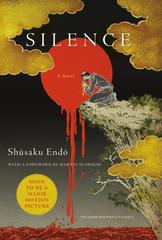 In 1639, two Portuguese priests, Sebastian Rodrigues and Francisco Garrpe, sneak into Japan. They have two goals: to continue Jesuit missionary work in a country where Christianity is violently repressed and to discover the fate of their mentor, Father Ferreira, who has reportedly apostatized by denouncing his faith under duress. Rodrigues and Garrpe arrive at a fishing village in Southern Japan, where a community of hidden Christians still practice their religion even after the Tokugawa Shogunate banned it. The Fathers hide in a hillside hut during the day, deliver sacraments in secret at night and subsist on what little food the starving villagers can spare. It is the first of many trials they endure in Silence, the landmark work of 20th-century Japanese literature by Shūsaku Endō.
In 1639, two Portuguese priests, Sebastian Rodrigues and Francisco Garrpe, sneak into Japan. They have two goals: to continue Jesuit missionary work in a country where Christianity is violently repressed and to discover the fate of their mentor, Father Ferreira, who has reportedly apostatized by denouncing his faith under duress. Rodrigues and Garrpe arrive at a fishing village in Southern Japan, where a community of hidden Christians still practice their religion even after the Tokugawa Shogunate banned it. The Fathers hide in a hillside hut during the day, deliver sacraments in secret at night and subsist on what little food the starving villagers can spare. It is the first of many trials they endure in Silence, the landmark work of 20th-century Japanese literature by Shūsaku Endō.
Endō (1923-1996), himself a Roman Catholic, won multiple prestigious Japanese awards for his work and is considered among the greatest of Japan's postwar novelists. Silence (1966) is a multilayered tale of deeply personal religious turmoil. Rodrigues, throughout the many tribulations leading to the novel's morally ambiguous climax, grapples with his beliefs in ways mirroring the author's own struggle between his Christian faith and Japanese culture.
Adapting Silence into a film has been a passion project of director Martin Scorsese since the early '90s. In his foreword to a new edition published by Picador Modern Classics ($16, 9781250082244) last January, Scorsese says Silence has "given me a kind of sustenance that I have found in only a very few works of art." His adaptation, starring Andrew Garfield, Adam Driver and Liam Neeson, will be distributed by Paramount later this year. The Endō estate has retained all e-book rights to Silence, meaning Picador's re-release is available only in paperback. --Tobias Mutter

